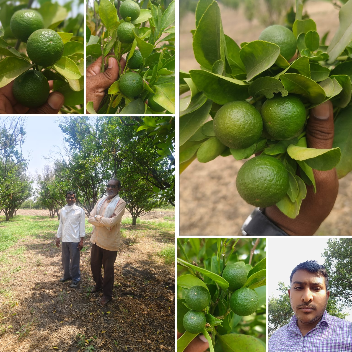Revitalizing Our Roots: How Soil Health Can Slash Carbon Footprints - A Practical Guide for Indian Farmers and Beyond

In an era defined by climate change and the urgent need for environmental sustainability, the ground beneath our feet holds a powerful secret: healthy soil is a critical ally in reducing carbon footprints. This isn't just an environmental concept; it's a practical pathway for farmers to boost productivity, enhance resilience, and contribute to a healthier planet.
This guide delves into the vital connection between soil health and carbon sequestration, offering actionable strategies specifically tailored for farmers in India and applicable worldwide.
1.Soil Health and Carbon Footprints
1.1. The Soil's Carbon Sponge: Carbon Sequestration Explained
Imagine soil as a vast, natural sponge capable of soaking up carbon dioxide (CO₂) from the atmosphere – this process is carbon sequestration. Globally, soils are the largest terrestrial carbon sink, holding more carbon than all the Earth's vegetation and the atmosphere combined.
How it Works: Plants, through photosynthesis, absorb atmospheric CO₂ and convert it into organic matter. When these plants die and decompose, or shed leaves and roots, this carbon-rich material becomes part of the soil. Soil microorganisms then break down this organic matter, forming stable carbon compounds that can be stored for decades, even centuries.
The Impact of Healthy Soil on Atmospheric Carbon: Healthy soils, rich in soil organic carbon (SOC), have an incredible capacity to sequester carbon. Studies suggest that improving soil health globally could potentially sequester up to 30% of global carbon emissions annually. In India, decades of unsustainable farming have led to significant SOC loss, highlighting the immense potential for carbon recapture through improved soil management.
The Intertwined Fate: Soil Health and Climate Change: Poor soil management practices like excessive tillage, deforestation for agriculture, and monoculture farming disrupt this natural carbon storage, releasing stored carbon back into the atmosphere as greenhouse gases, thus exacerbating climate change. Conversely, adopting practices that nurture soil health, such as cover cropping and organic farming, actively increase carbon sequestration, acting as a powerful climate change mitigation tool.
1.2. Key Indicators: Gauging Your Soil's Health
Farmers can effectively monitor and improve their soil's health by observing key indicators that reflect its fertility, structure, and carbon-storing capacity.
Understanding the Vital Signs:
Organic Matter: This is the cornerstone of healthy soil, composed of decomposed plant and animal residues. For every 1% increase in soil organic matter, the soil can hold approximately 20,000 gallons of plant-available water per acre. Higher organic matter directly translates to improved soil structure, enhanced nutrient availability, and greater carbon storage.
pH Levels: The acidity or alkalinity of the soil significantly impacts nutrient availability and microbial activity. Maintaining the optimal pH range for your crops (typically between 6.0 and 7.0 for most crops) is crucial for overall soil health.
Nutrient Levels (NPK): Essential macronutrients like Nitrogen (N), Phosphorus (P), and Potassium (K) are vital for plant growth. However, over-fertilization can disrupt soil microbial balance and even lead to nitrous oxide emissions, a potent greenhouse gas. Regular soil testing ensures balanced nutrient application.
The Unsung Heroes: Soil Biodiversity: A thriving community of microorganisms (bacteria, fungi), nematodes, and soil insects is essential for nutrient cycling, improved soil structure, and enhanced carbon sequestration. A single gram of healthy soil can contain billions of microorganisms. This biodiversity contributes significantly to a resilient and sustainable farming system.
Tools for Assessment: Farmers in India can leverage resources like soil health cards provided by government programs, which offer insights into key parameters like pH, organic matter, and nutrient levels. Additionally, simple on-farm assessments like visual inspection of soil structure (e.g., aggregation, compaction) and root growth patterns can provide valuable clues. Soil testing in laboratories offers more detailed analysis.
1.3. Soil Health: The Bedrock of Sustainable Agriculture
In a nation like India, where agriculture supports a vast majority of the population, soil health is not just an environmental concern; it's fundamental to sustainable livelihoods and food security.
Nourishing the Nation: Food Security Through Healthy Soil: Healthy soil boosts crop yields by improving water retention, making nutrients readily available to plants, and enhancing their resistance to diseases and pests. In regions facing water scarcity and soil erosion, adopting soil health practices is crucial for ensuring stable harvests and farm incomes. Studies have shown that improving soil health can lead to yield increases of 20-50% in various crops.
A Symbiotic Relationship: Sustainable Practices and Carbon Management: Sustainable agricultural practices like organic farming, agroforestry (integrating trees with crops and livestock), and agroecology are inherently linked to both improved soil health and reduced greenhouse gas emissions. By actively managing carbon within the soil, farmers become key players in combating climate change while simultaneously enhancing their farm's long-term productivity and resilience.
Conclusion: Cultivating a Greener Future, One Seed at a Time
Enhancing soil health is no longer a niche environmental pursuit; it's a practical and essential strategy for farmers in India and across the globe. By understanding the profound role of soil in carbon sequestration and embracing sustainable practices, farmers can significantly reduce their carbon footprint while building more resilient and productive agricultural systems.
Monitoring key soil health indicators, fostering soil biodiversity, and implementing techniques like cover cropping (planting non-cash crops to protect and improve soil), reduced or no-till farming (minimizing soil disturbance), crop rotation (planting different crops in sequence), and organic farming practices (avoiding synthetic fertilizers and pesticides) are vital steps.
These actions not only contribute to mitigating climate change by drawing down atmospheric carbon but also bolster food security, improve water quality, and enhance the economic stability of farming communities. As soil health flourishes, so does its capacity to sequester atmospheric carbon, creating a positive feedback loop that benefits both the environment and agricultural livelihoods. Embracing these soil health solutions is not just an option; it's the foundation for a more sustainable and climate-resilient future for agriculture.

